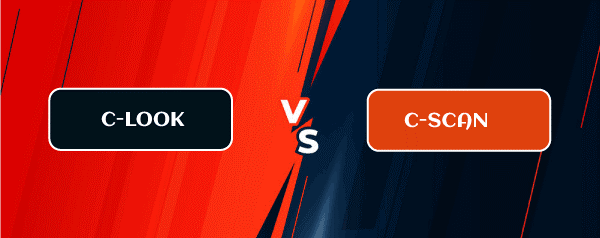Difference between C-LOOK and C-SCAN Disk Scheduling Algorithm
Disk scheduling is used by operating systems to arrange the arrival of I/O requests to the disc. I/O scheduling is another name for disc scheduling. Disk scheduling is necessary because several I/O requests may occur from various processes, and the disc controller can only service one I/O request at a time. As a result, further I/O requests must wait in the queue and be scheduled. Two or more requests may be separated by a significant distance, resulting in increased disc arm movement. Because hard drives are one of the slowest components of a computer system, they must be accessible quickly. Some of the key terminology used in disc scheduling are listed below:
Seek Time: The time taken by the disk arm to identify a specific track where data is read or written is known as seek time. As a result, the disc scheduling technique with the shortest average seek time is preferable.
Rotational latency is the time it takes for a disk sector to spin up to a position that allows it to reach the read/write heads. As a result, the disc scheduling approach with the shortest rotational delay is preferable.
Transmission time: The time taken to transfer data is determined by the rotational speed of the disk and the amount of bytes to be transferred.
The total of search time, rotational delay, and transfer time is known as disc access time.
Disk Response Time: Response time is the average time that a request spends waiting for an I/O operation to complete. Average response time is the time taken to respond to all requests. Variance Response Time (VRT) is a metric for determining how individual requests are handled in terms of average response time. As a result, the disc scheduling algorithm with the shortest variance response time is preferable.
C-SCAN
The C-LOOK algorithm is a hybrid of the LOOK and C-SCAN algorithms. In this method, The head proceeds in the opposite way from the first request to the last, serving all requests in between. After fulfilling the last request in one direction, the head leaps in the opposite direction, proceeds to the remaining requests, and then serves them as before. The head pointer will travel up to the last request to disk, unlike C-SCAN.
Benefits:
- When there are no requests to be served, it does not force the head to move until the end of the disc.
- It decreases the time spent waiting for the head to return to the cylinders it has just visited.
- When compared to the LOOK Algorithm, it performs better.
- It does not result in hunger.
- It has a low reaction time and waiting time variance.
Drawback:
- There is a cost associated with locating the final requests.
C-LOOK
The Circular Elevator algorithm, commonly known as the C-SCAN algorithm, is a modified version of the SCAN method. In this technique the head pointer starts at one end of the disk and moves to the other, serving all requests in between. After reaching the other end, the head spins and returns to the start, where it serves the same remaining requests as before. Unlike a C-look, the head pointer moves to the end of the disk, regardless of whether there is a request or not.
Benefits:
- When compared to the SCAN Algorithm, the waiting time for the cylinders recently visited by the head is minimised.
- It ensures a consistent wait time.
- It has a quicker response time.
Drawback:
- Compared to the scan algorithm, it induces more seek movements.
- This causes the head to proceed all the way to the end of the disk, even though there are no requests waiting to be served.

Main Differences
|
S no. |
C-LOOK |
C-SCAN |
|
1. |
The C-LOOK method outperforms all other disc scheduling techniques. |
C-SCAN, on the other hand, lags behind C-LOOK in terms of performance. |
|
2. |
C-LOOK is a better method for handling requests than C-SCAN. |
In comparison to the C-LOOK method, the processing of requests is not as good here. |
|
3. |
C-LOOK has a low reaction time and waiting time variance. |
C-SCAN ensures a consistent wait time and reaction time. |
|
4. |
The overhead of locating the end requests in the C-LOOK algorithm is significant. |
When compared to C-LOOK, the C-SCAN algorithm takes longer to seek. |
|
5. |
The head of the C-look algorithm proceeds from 53 to serve all requests in the right direction until it reaches the last request in one end in the example above.Then it moves on to the remaining requests, serving them only in the correct direction. |
The head of the C-scan algorithm goes through 53 and serves all requests in the right direction until it reaches the other end in the example above. Then it jumps to the opposite end of the network and requests only the correct one. |